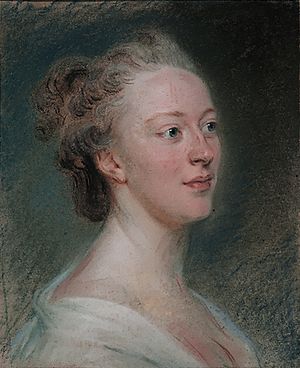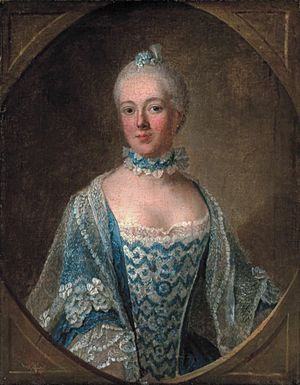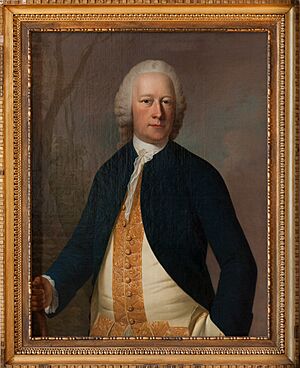Isabelle de Charrière facts for kids
Quick facts for kids
Isabelle de Charrière
|
|
|---|---|
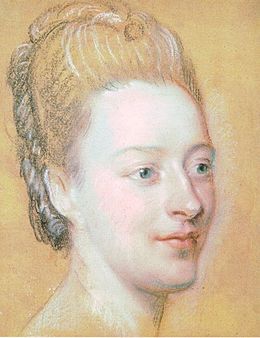
Portrait of Isabelle de Charrière by Maurice-Quentin de La Tour, 1771 Saint-Quentin, Aisne, Musée Antoine-Lécuyer
|
|
| Born | 20 October 1740 Castle Zuylen, Utrecht, Netherlands |
| Died | 27 December 1805 (aged 65) Le Pontet, Colombier, Neuchâtel, Prussia |
| Pen name | Belle van Zuylen, Belle de Zuylen, Zélide, Abbé de la Tour |
| Occupation | Novelist, poet, playwright |
| Nationality | |
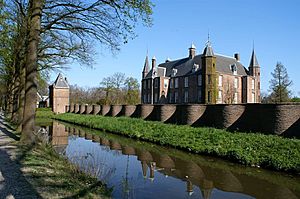
Isabelle de Charrière (born October 20, 1740 – died December 27, 1805) was an important writer from the Enlightenment period. She was known as Belle van Zuylen in the Netherlands, where she was born. Later, she was called Madame Isabelle de Charrière after she married and moved to Colombier, Neuchâtel in Switzerland.
Isabelle is famous for her letters and novels. She also wrote plays, music, and short essays called pamphlets. She was very interested in the society and politics of her time. Her writings during the French Revolution are especially important.
Contents
Isabelle's Early Life and Education
Isabelle was born at Zuylen Castle near Utrecht in the Netherlands. Her full birth name was Isabella Agneta Elisabeth van Tuyll van Serooskerken. Her parents were Diederik Jacob van Tuyll van Serooskerken and Jacoba Helena de Vicq. She was the oldest of their seven children.
Her parents were wealthy and important. They were known for being a very old noble family. In winter, they lived in their house in the city of Utrecht.
Traveling and Learning Languages
In 1750, when Isabelle was ten, she went to Geneva and traveled through Switzerland and France. She was with her French-speaking teacher, Jeanne-Louise Prevost. For a whole year, she only spoke French. When she returned home, she had to learn Dutch again! French remained her favorite language for writing and speaking throughout her life.
Isabelle received a much better education than most girls at that time. Her parents had modern ideas and let her study many subjects. She learned mathematics, physics, and several languages, including Latin, Italian, German, and English. She was a very talented student. She also loved music and studied with the composer Niccolò Zingarelli in 1790.
Early Relationships and Marriage
When Isabelle was 14, she fell in love with a Polish count, Peter Dönhoff, but he was not interested in her. As she grew up, many men wanted to marry her. However, she often rejected them because they didn't keep their promises, or they backed away because she was so smart and independent. She wanted to marry for love, but also saw marriage as a way to gain more freedom.
In 1771, she married Charles-Emmanuel de Charrière de Penthaz. He had been her brother's private tutor. After their marriage, she became known as Isabelle de Charrière. They moved to Le Pontet in Colombier, Switzerland, near Neuchâtel. This area was then ruled by Frederick the Great. Neuchâtel allowed people to practice any religion, so many refugees, like the famous writer Jean-Jacques Rousseau, came to live there.
Isabelle's Wealth and Views on Society
In 1778, Isabelle inherited a large fortune from her parents. Part of this money came from investments in colonial companies, like the Dutch West India Company and the British East India Company. These companies were involved in trade and plantations overseas.
Isabelle wrote about what she called the "horrors" in the colonies in her letters. This shows she was not okay with the problems caused by colonial practices. Within five years of getting her inheritance, she sold 70% of her investments in these colonial companies.
Important Letters and Friends
Isabelle de Charrière wrote many letters to different people. These included thinkers like David-Louis Constant d'Hermenches, James Boswell, Benjamin Constant, and her German translator Ludwig Ferdinand Huber.
Correspondence with David-Louis Constant d'Hermenches
In 1760, Isabelle met David-Louis Constant d'Hermenches, a Swiss officer. After some time, she started a secret and close correspondence with him that lasted about 15 years. He became one of her most important letter-writing friends.
Letters with James Boswell
The Scottish writer James Boswell met Isabelle often in Utrecht in 1763-1764. He was studying law at Utrecht University. He called her Zélide, which was a name she used for herself in a self-portrait. They wrote letters to each other for several years. Boswell told her he wasn't in love with her, and she famously replied: "We agree, because I have no talent for subordination." This shows her independent spirit.
Friendship with Benjamin Constant
In 1786, Madame de Charrière met Benjamin Constant, who was the nephew of David-Louis Constant d'Hermenches. Benjamin was also a writer. He visited her in Colombier many times. They even wrote a novel together that was made up of letters, called an epistolary novel. Their exchange of letters continued until the end of her life.
Isabelle's Published Works
Isabelle de Charrière wrote many different types of works, including novels, pamphlets, plays, and poems. She also composed music. She was most active as a writer after she moved to Colombier. Her writings often explored her religious doubts, the role of noble families, and how women were educated.
Early Novels and Satire
Her first novel, Le Noble, was published in 1763. It was a funny story that made fun of noble people. She published it without her name, but her identity was soon discovered. Her parents were worried and bought all the copies of the book to stop it from being sold.
Even so, the book became known in Europe. The famous German poet Johann Wolfgang von Goethe even reviewed a German translation of it.
In 1784, she published two more novels: Lettres neuchâteloises (Letters from Neuchâtel) and Lettres de Mistriss Henley publiées par son amie (Letters from Mistress Henley published by her friend). Both were epistolary novels, meaning they were told through letters. She liked this style of writing.
Writings on Politics and Revolution
In 1788, she started publishing pamphlets about the political situations in the Netherlands, France, and Switzerland. She was a big fan of the philosopher Jean-Jacques Rousseau. She helped publish his famous work, Confessions, after he died in 1789. She also wrote her own pamphlets about Rousseau around this time.
During the French Revolution, many noble people fled to Neuchâtel. Madame de Charrière became friends with some of them. However, she also wrote works that criticized these noble refugees. She felt that many of them had not learned anything important from the Revolution.
Music Compositions
Isabelle de Charrière also wrote music. She wrote words and music for several pieces, but sadly, most of them are now lost. She even sent a script for an opera, called Les Phéniciennes, to Mozart, hoping he would set it to music. We don't know if he ever replied.
Her musical works that still exist include six minuets for a string quartet, nine piano sonatas, and ten songs.
Interesting Facts About Isabelle
- An asteroid discovered in 1991 was named 9604 Bellevanzuylen in her honor.
- A film about her life, Belle van Zuylen - Madame de Charrière, was made in 1993.
- Utrecht University in the Netherlands has a special "Belle van Zuylen Chair" for professors.
- There is an annual "Belle van Zuylen Lecture" at the International Literature Festival Utrecht. Famous writers like Margaret Atwood have given this lecture. Since 2020, speakers receive a small sculpture called the Belle van Zuylenring.
See also
 In Spanish: Isabelle de Charrière para niños
In Spanish: Isabelle de Charrière para niños


